5EML: Analyzing Employment Law at National Bank Dubai, Saudi Arabia
VerifiedAdded on 2023/06/14
|23
|5816
|90
Report
AI Summary
This report provides a comprehensive analysis of employment law, focusing on key areas such as employment contracts, discrimination, wages, leaves, health and safety, unfair dismissal, and redundancy. It examines the aims and objectives of employment law, the role of tribunals and courts, and methods of dispute resolution. The report also addresses the importance of fair recruitment processes, the establishment and variation of employment contracts, and the legal requirements for managing redundancy. Examples from the author's experience at National Bank Dubai Saudi Arabian branch are used to illustrate the practical application of these legal principles. The document emphasizes the need for human resource managers to understand and comply with employment law to ensure fair treatment of employees and avoid legal repercussions. Desklib provides a platform to access this document and many similar solved assignments.
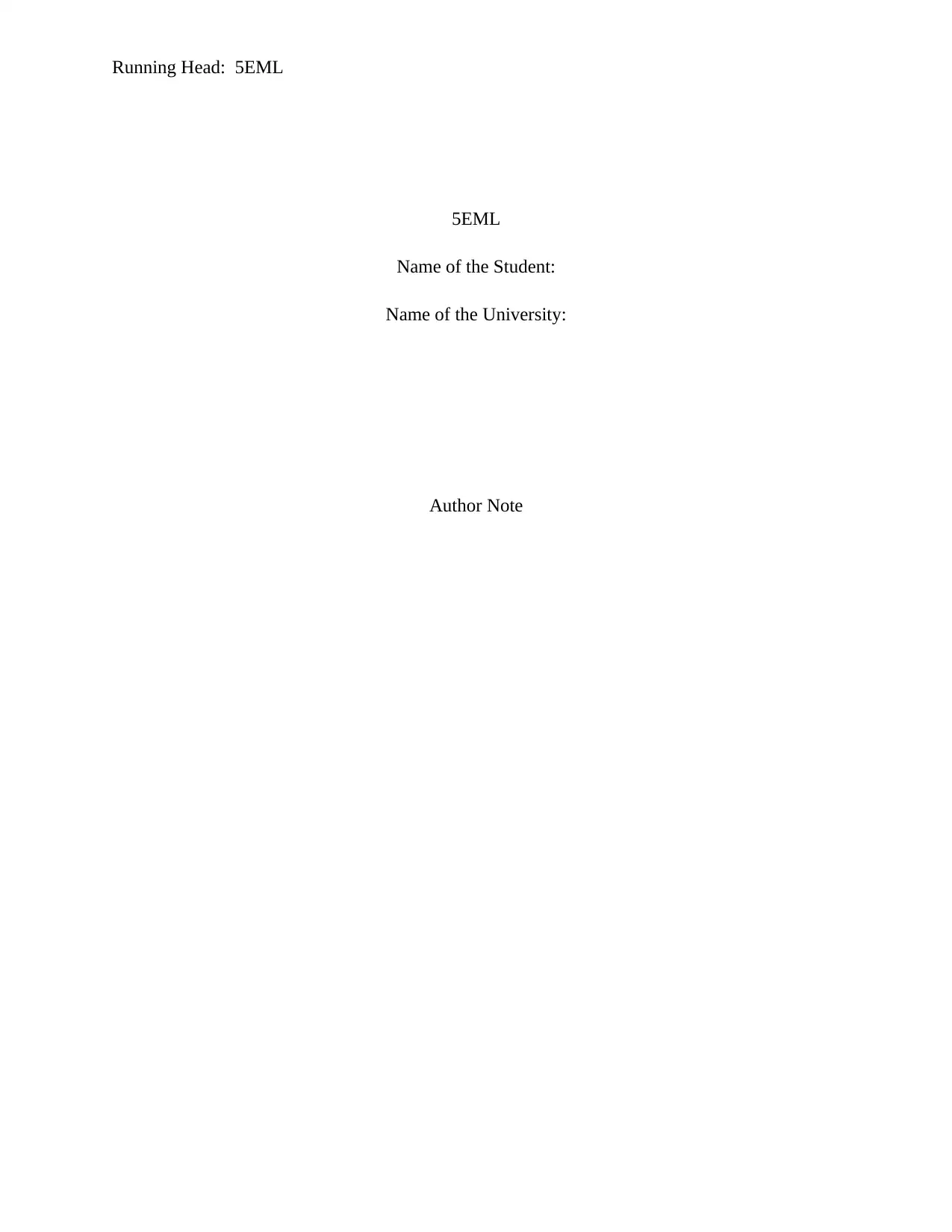
Running Head: 5EML
5EML
Name of the Student:
Name of the University:
Author Note
5EML
Name of the Student:
Name of the University:
Author Note
Paraphrase This Document
Need a fresh take? Get an instant paraphrase of this document with our AI Paraphraser
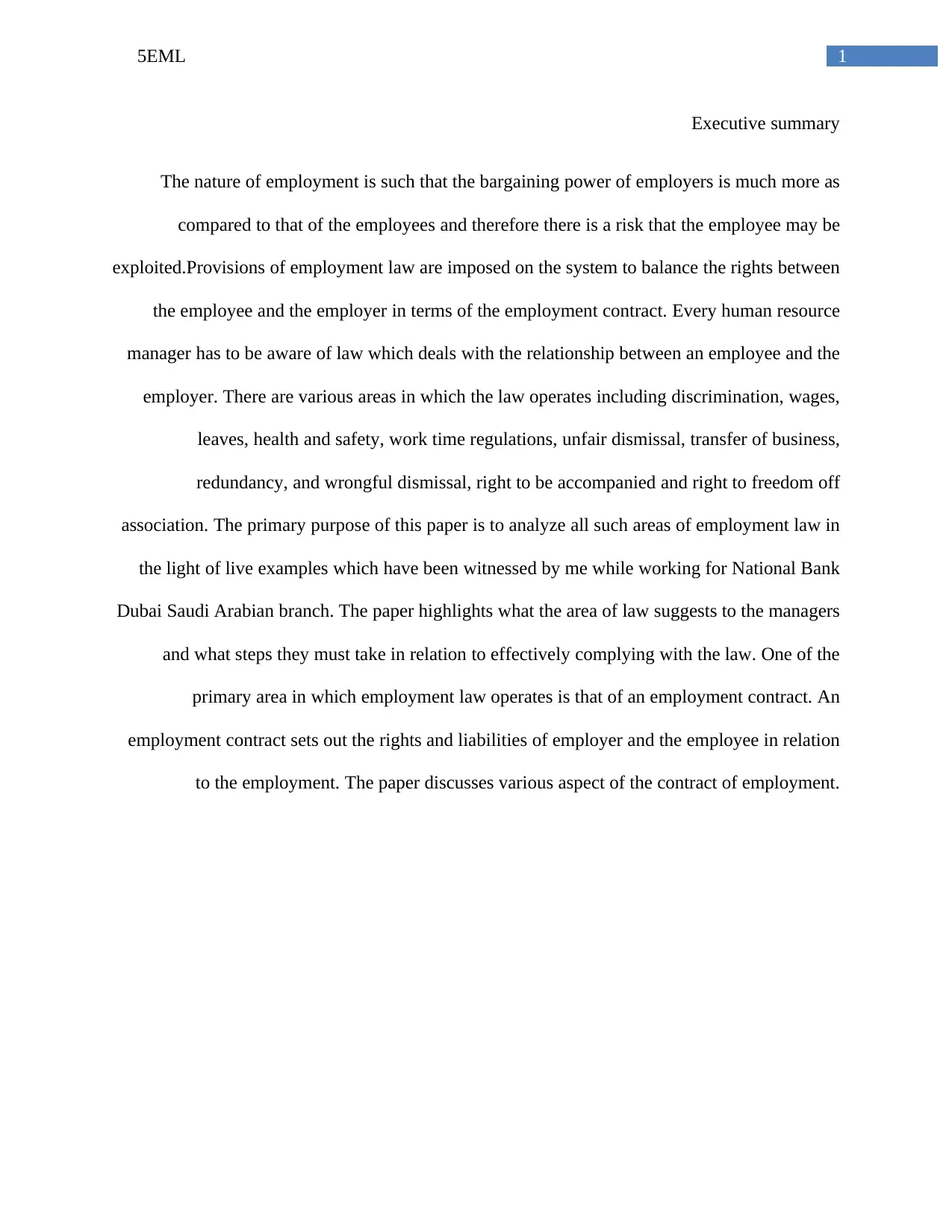
15EML
Executive summary
The nature of employment is such that the bargaining power of employers is much more as
compared to that of the employees and therefore there is a risk that the employee may be
exploited.Provisions of employment law are imposed on the system to balance the rights between
the employee and the employer in terms of the employment contract. Every human resource
manager has to be aware of law which deals with the relationship between an employee and the
employer. There are various areas in which the law operates including discrimination, wages,
leaves, health and safety, work time regulations, unfair dismissal, transfer of business,
redundancy, and wrongful dismissal, right to be accompanied and right to freedom off
association. The primary purpose of this paper is to analyze all such areas of employment law in
the light of live examples which have been witnessed by me while working for National Bank
Dubai Saudi Arabian branch. The paper highlights what the area of law suggests to the managers
and what steps they must take in relation to effectively complying with the law. One of the
primary area in which employment law operates is that of an employment contract. An
employment contract sets out the rights and liabilities of employer and the employee in relation
to the employment. The paper discusses various aspect of the contract of employment.
Executive summary
The nature of employment is such that the bargaining power of employers is much more as
compared to that of the employees and therefore there is a risk that the employee may be
exploited.Provisions of employment law are imposed on the system to balance the rights between
the employee and the employer in terms of the employment contract. Every human resource
manager has to be aware of law which deals with the relationship between an employee and the
employer. There are various areas in which the law operates including discrimination, wages,
leaves, health and safety, work time regulations, unfair dismissal, transfer of business,
redundancy, and wrongful dismissal, right to be accompanied and right to freedom off
association. The primary purpose of this paper is to analyze all such areas of employment law in
the light of live examples which have been witnessed by me while working for National Bank
Dubai Saudi Arabian branch. The paper highlights what the area of law suggests to the managers
and what steps they must take in relation to effectively complying with the law. One of the
primary area in which employment law operates is that of an employment contract. An
employment contract sets out the rights and liabilities of employer and the employee in relation
to the employment. The paper discusses various aspect of the contract of employment.
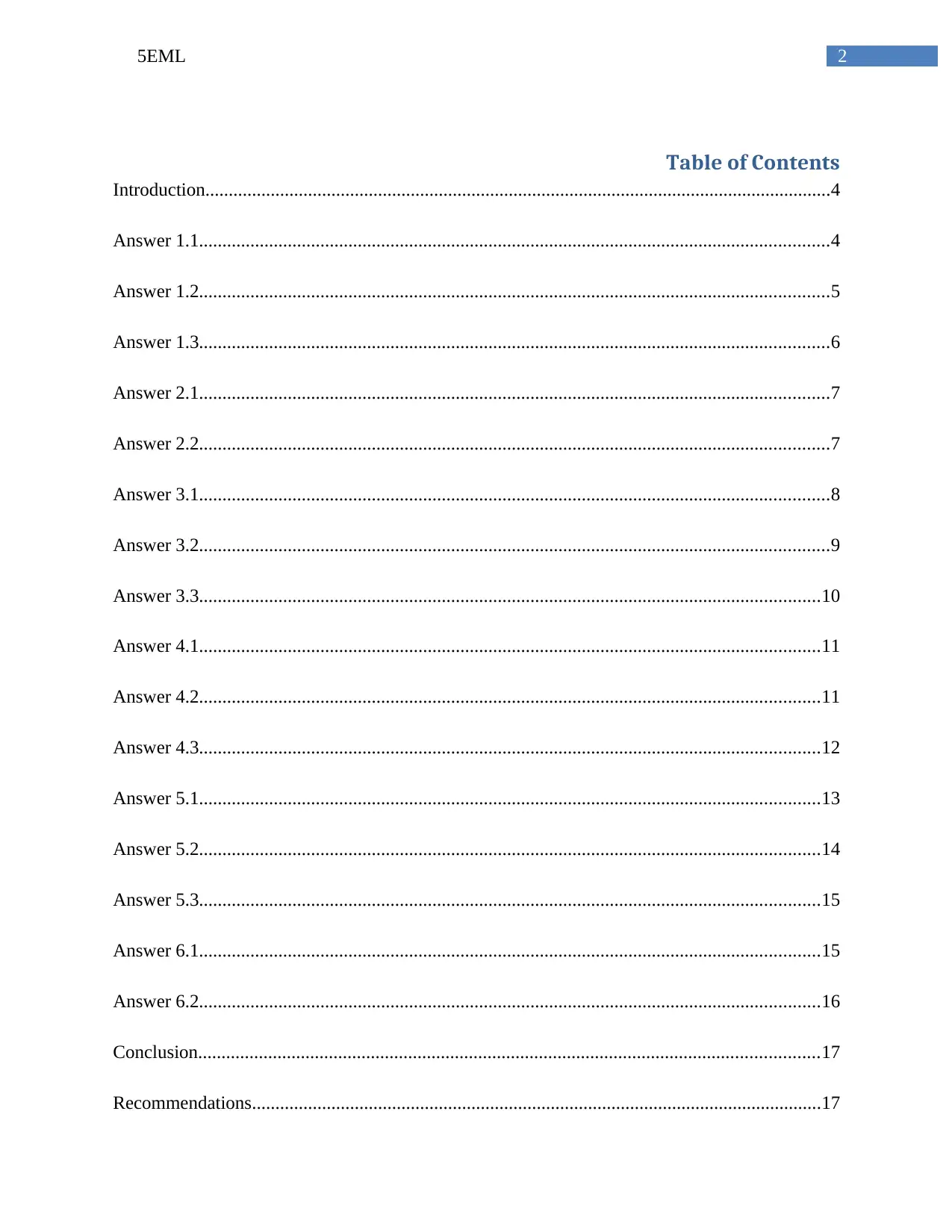
25EML
Table of Contents
Introduction......................................................................................................................................4
Answer 1.1.......................................................................................................................................4
Answer 1.2.......................................................................................................................................5
Answer 1.3.......................................................................................................................................6
Answer 2.1.......................................................................................................................................7
Answer 2.2.......................................................................................................................................7
Answer 3.1.......................................................................................................................................8
Answer 3.2.......................................................................................................................................9
Answer 3.3.....................................................................................................................................10
Answer 4.1.....................................................................................................................................11
Answer 4.2.....................................................................................................................................11
Answer 4.3.....................................................................................................................................12
Answer 5.1.....................................................................................................................................13
Answer 5.2.....................................................................................................................................14
Answer 5.3.....................................................................................................................................15
Answer 6.1.....................................................................................................................................15
Answer 6.2.....................................................................................................................................16
Conclusion.....................................................................................................................................17
Recommendations..........................................................................................................................17
Table of Contents
Introduction......................................................................................................................................4
Answer 1.1.......................................................................................................................................4
Answer 1.2.......................................................................................................................................5
Answer 1.3.......................................................................................................................................6
Answer 2.1.......................................................................................................................................7
Answer 2.2.......................................................................................................................................7
Answer 3.1.......................................................................................................................................8
Answer 3.2.......................................................................................................................................9
Answer 3.3.....................................................................................................................................10
Answer 4.1.....................................................................................................................................11
Answer 4.2.....................................................................................................................................11
Answer 4.3.....................................................................................................................................12
Answer 5.1.....................................................................................................................................13
Answer 5.2.....................................................................................................................................14
Answer 5.3.....................................................................................................................................15
Answer 6.1.....................................................................................................................................15
Answer 6.2.....................................................................................................................................16
Conclusion.....................................................................................................................................17
Recommendations..........................................................................................................................17
⊘ This is a preview!⊘
Do you want full access?
Subscribe today to unlock all pages.

Trusted by 1+ million students worldwide

35EML
References......................................................................................................................................19
References......................................................................................................................................19
Paraphrase This Document
Need a fresh take? Get an instant paraphrase of this document with our AI Paraphraser
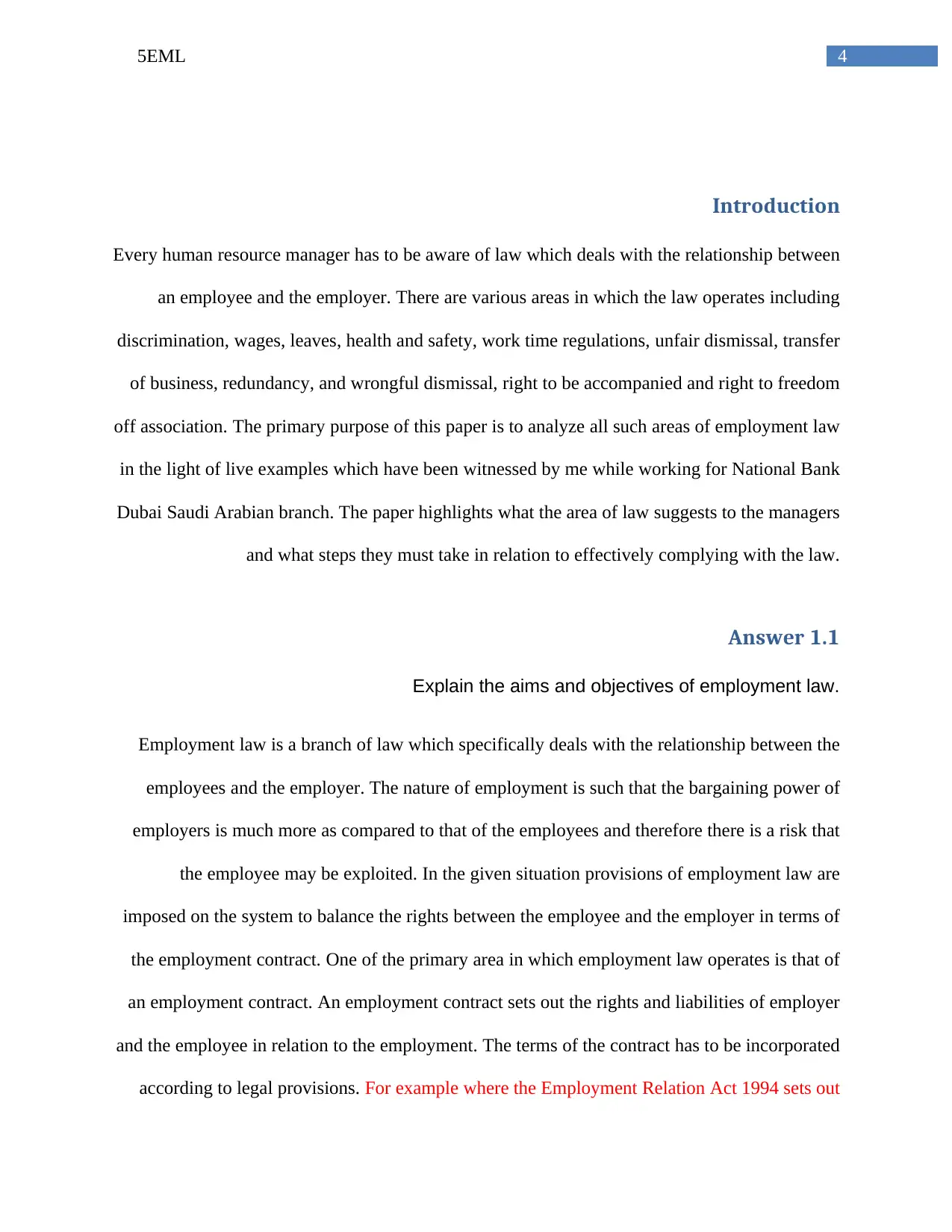
45EML
Introduction
Every human resource manager has to be aware of law which deals with the relationship between
an employee and the employer. There are various areas in which the law operates including
discrimination, wages, leaves, health and safety, work time regulations, unfair dismissal, transfer
of business, redundancy, and wrongful dismissal, right to be accompanied and right to freedom
off association. The primary purpose of this paper is to analyze all such areas of employment law
in the light of live examples which have been witnessed by me while working for National Bank
Dubai Saudi Arabian branch. The paper highlights what the area of law suggests to the managers
and what steps they must take in relation to effectively complying with the law.
Answer 1.1
Explain the aims and objectives of employment law.
Employment law is a branch of law which specifically deals with the relationship between the
employees and the employer. The nature of employment is such that the bargaining power of
employers is much more as compared to that of the employees and therefore there is a risk that
the employee may be exploited. In the given situation provisions of employment law are
imposed on the system to balance the rights between the employee and the employer in terms of
the employment contract. One of the primary area in which employment law operates is that of
an employment contract. An employment contract sets out the rights and liabilities of employer
and the employee in relation to the employment. The terms of the contract has to be incorporated
according to legal provisions. For example where the Employment Relation Act 1994 sets out
Introduction
Every human resource manager has to be aware of law which deals with the relationship between
an employee and the employer. There are various areas in which the law operates including
discrimination, wages, leaves, health and safety, work time regulations, unfair dismissal, transfer
of business, redundancy, and wrongful dismissal, right to be accompanied and right to freedom
off association. The primary purpose of this paper is to analyze all such areas of employment law
in the light of live examples which have been witnessed by me while working for National Bank
Dubai Saudi Arabian branch. The paper highlights what the area of law suggests to the managers
and what steps they must take in relation to effectively complying with the law.
Answer 1.1
Explain the aims and objectives of employment law.
Employment law is a branch of law which specifically deals with the relationship between the
employees and the employer. The nature of employment is such that the bargaining power of
employers is much more as compared to that of the employees and therefore there is a risk that
the employee may be exploited. In the given situation provisions of employment law are
imposed on the system to balance the rights between the employee and the employer in terms of
the employment contract. One of the primary area in which employment law operates is that of
an employment contract. An employment contract sets out the rights and liabilities of employer
and the employee in relation to the employment. The terms of the contract has to be incorporated
according to legal provisions. For example where the Employment Relation Act 1994 sets out
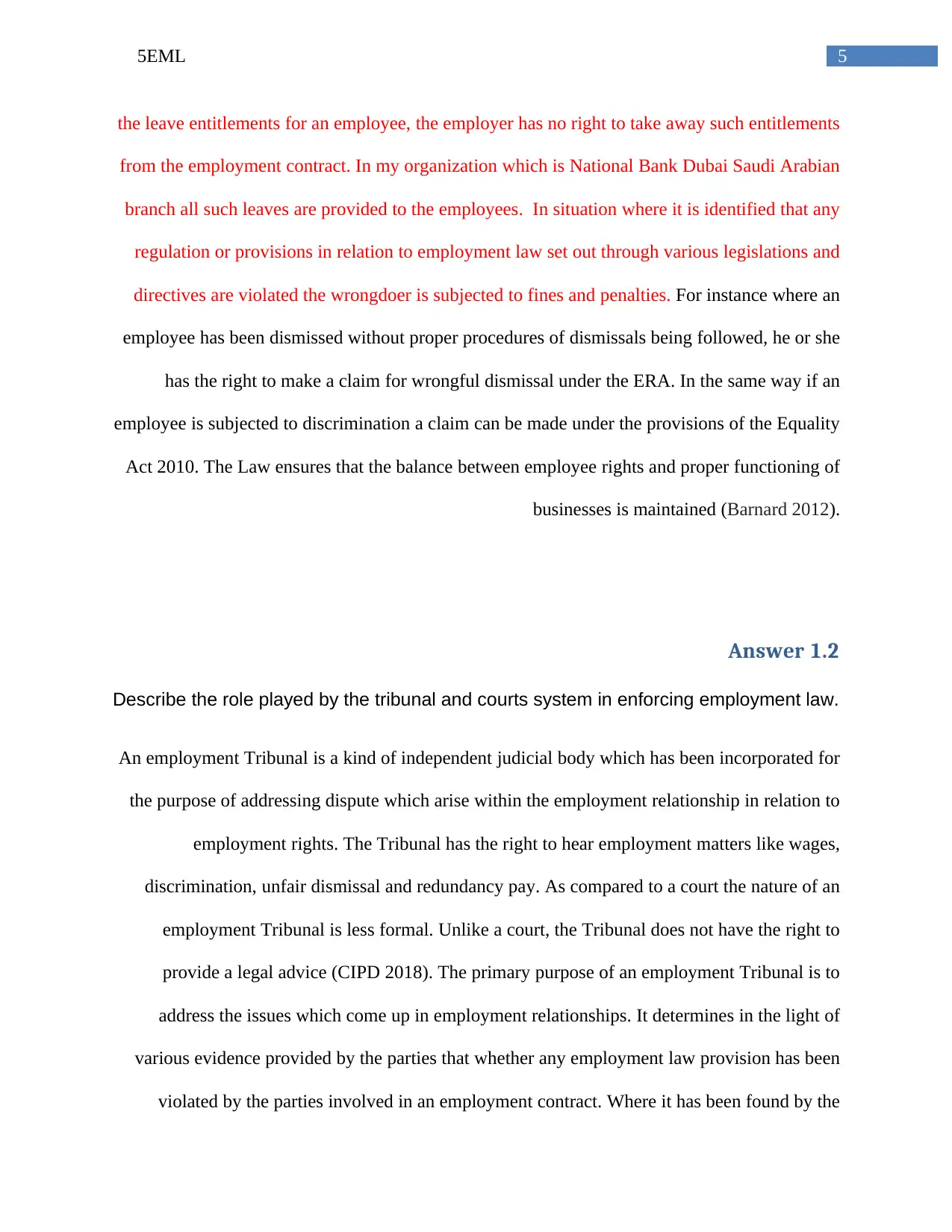
55EML
the leave entitlements for an employee, the employer has no right to take away such entitlements
from the employment contract. In my organization which is National Bank Dubai Saudi Arabian
branch all such leaves are provided to the employees. In situation where it is identified that any
regulation or provisions in relation to employment law set out through various legislations and
directives are violated the wrongdoer is subjected to fines and penalties. For instance where an
employee has been dismissed without proper procedures of dismissals being followed, he or she
has the right to make a claim for wrongful dismissal under the ERA. In the same way if an
employee is subjected to discrimination a claim can be made under the provisions of the Equality
Act 2010. The Law ensures that the balance between employee rights and proper functioning of
businesses is maintained (Barnard 2012).
Answer 1.2
Describe the role played by the tribunal and courts system in enforcing employment law.
An employment Tribunal is a kind of independent judicial body which has been incorporated for
the purpose of addressing dispute which arise within the employment relationship in relation to
employment rights. The Tribunal has the right to hear employment matters like wages,
discrimination, unfair dismissal and redundancy pay. As compared to a court the nature of an
employment Tribunal is less formal. Unlike a court, the Tribunal does not have the right to
provide a legal advice (CIPD 2018). The primary purpose of an employment Tribunal is to
address the issues which come up in employment relationships. It determines in the light of
various evidence provided by the parties that whether any employment law provision has been
violated by the parties involved in an employment contract. Where it has been found by the
the leave entitlements for an employee, the employer has no right to take away such entitlements
from the employment contract. In my organization which is National Bank Dubai Saudi Arabian
branch all such leaves are provided to the employees. In situation where it is identified that any
regulation or provisions in relation to employment law set out through various legislations and
directives are violated the wrongdoer is subjected to fines and penalties. For instance where an
employee has been dismissed without proper procedures of dismissals being followed, he or she
has the right to make a claim for wrongful dismissal under the ERA. In the same way if an
employee is subjected to discrimination a claim can be made under the provisions of the Equality
Act 2010. The Law ensures that the balance between employee rights and proper functioning of
businesses is maintained (Barnard 2012).
Answer 1.2
Describe the role played by the tribunal and courts system in enforcing employment law.
An employment Tribunal is a kind of independent judicial body which has been incorporated for
the purpose of addressing dispute which arise within the employment relationship in relation to
employment rights. The Tribunal has the right to hear employment matters like wages,
discrimination, unfair dismissal and redundancy pay. As compared to a court the nature of an
employment Tribunal is less formal. Unlike a court, the Tribunal does not have the right to
provide a legal advice (CIPD 2018). The primary purpose of an employment Tribunal is to
address the issues which come up in employment relationships. It determines in the light of
various evidence provided by the parties that whether any employment law provision has been
violated by the parties involved in an employment contract. Where it has been found by the
⊘ This is a preview!⊘
Do you want full access?
Subscribe today to unlock all pages.

Trusted by 1+ million students worldwide
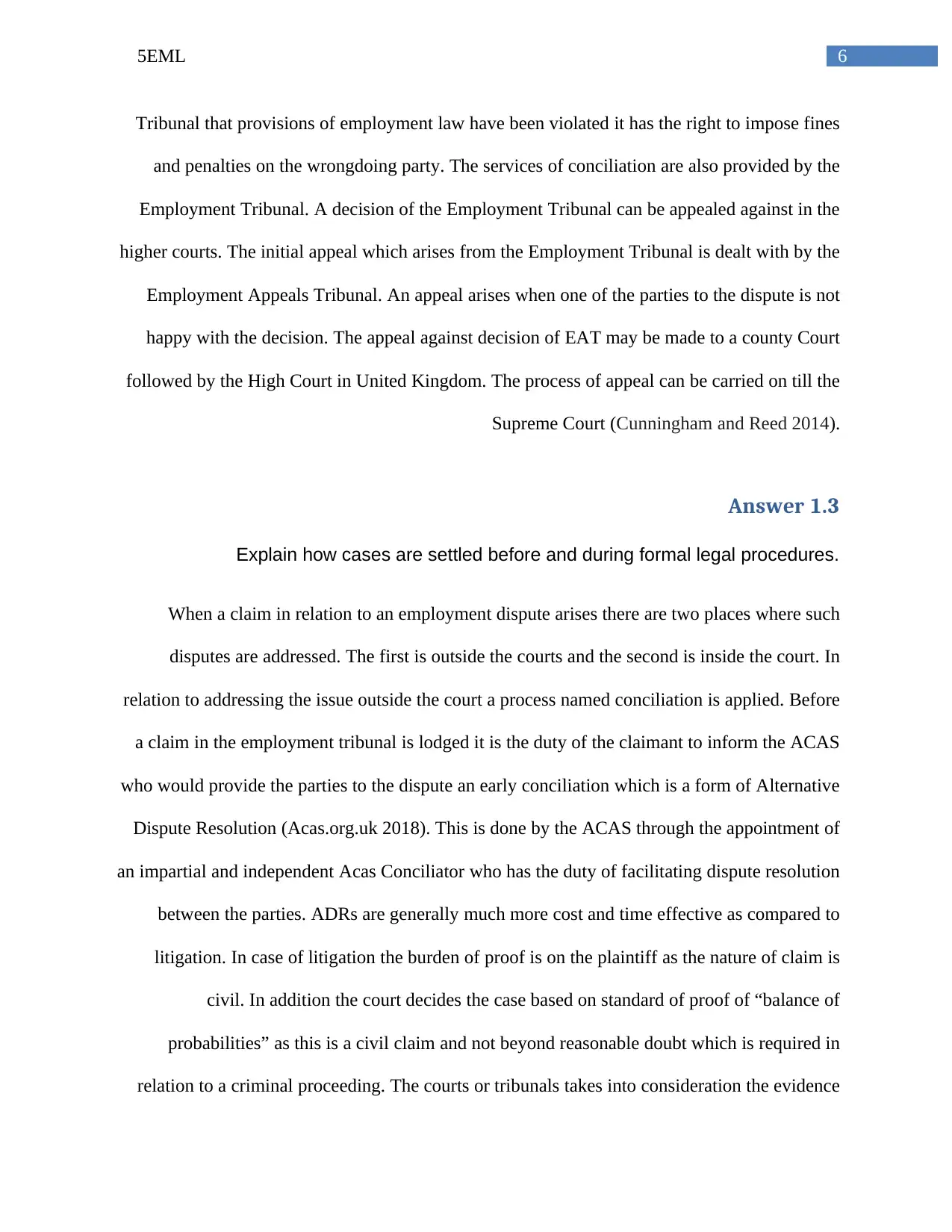
65EML
Tribunal that provisions of employment law have been violated it has the right to impose fines
and penalties on the wrongdoing party. The services of conciliation are also provided by the
Employment Tribunal. A decision of the Employment Tribunal can be appealed against in the
higher courts. The initial appeal which arises from the Employment Tribunal is dealt with by the
Employment Appeals Tribunal. An appeal arises when one of the parties to the dispute is not
happy with the decision. The appeal against decision of EAT may be made to a county Court
followed by the High Court in United Kingdom. The process of appeal can be carried on till the
Supreme Court (Cunningham and Reed 2014).
Answer 1.3
Explain how cases are settled before and during formal legal procedures.
When a claim in relation to an employment dispute arises there are two places where such
disputes are addressed. The first is outside the courts and the second is inside the court. In
relation to addressing the issue outside the court a process named conciliation is applied. Before
a claim in the employment tribunal is lodged it is the duty of the claimant to inform the ACAS
who would provide the parties to the dispute an early conciliation which is a form of Alternative
Dispute Resolution (Acas.org.uk 2018). This is done by the ACAS through the appointment of
an impartial and independent Acas Conciliator who has the duty of facilitating dispute resolution
between the parties. ADRs are generally much more cost and time effective as compared to
litigation. In case of litigation the burden of proof is on the plaintiff as the nature of claim is
civil. In addition the court decides the case based on standard of proof of “balance of
probabilities” as this is a civil claim and not beyond reasonable doubt which is required in
relation to a criminal proceeding. The courts or tribunals takes into consideration the evidence
Tribunal that provisions of employment law have been violated it has the right to impose fines
and penalties on the wrongdoing party. The services of conciliation are also provided by the
Employment Tribunal. A decision of the Employment Tribunal can be appealed against in the
higher courts. The initial appeal which arises from the Employment Tribunal is dealt with by the
Employment Appeals Tribunal. An appeal arises when one of the parties to the dispute is not
happy with the decision. The appeal against decision of EAT may be made to a county Court
followed by the High Court in United Kingdom. The process of appeal can be carried on till the
Supreme Court (Cunningham and Reed 2014).
Answer 1.3
Explain how cases are settled before and during formal legal procedures.
When a claim in relation to an employment dispute arises there are two places where such
disputes are addressed. The first is outside the courts and the second is inside the court. In
relation to addressing the issue outside the court a process named conciliation is applied. Before
a claim in the employment tribunal is lodged it is the duty of the claimant to inform the ACAS
who would provide the parties to the dispute an early conciliation which is a form of Alternative
Dispute Resolution (Acas.org.uk 2018). This is done by the ACAS through the appointment of
an impartial and independent Acas Conciliator who has the duty of facilitating dispute resolution
between the parties. ADRs are generally much more cost and time effective as compared to
litigation. In case of litigation the burden of proof is on the plaintiff as the nature of claim is
civil. In addition the court decides the case based on standard of proof of “balance of
probabilities” as this is a civil claim and not beyond reasonable doubt which is required in
relation to a criminal proceeding. The courts or tribunals takes into consideration the evidence
Paraphrase This Document
Need a fresh take? Get an instant paraphrase of this document with our AI Paraphraser
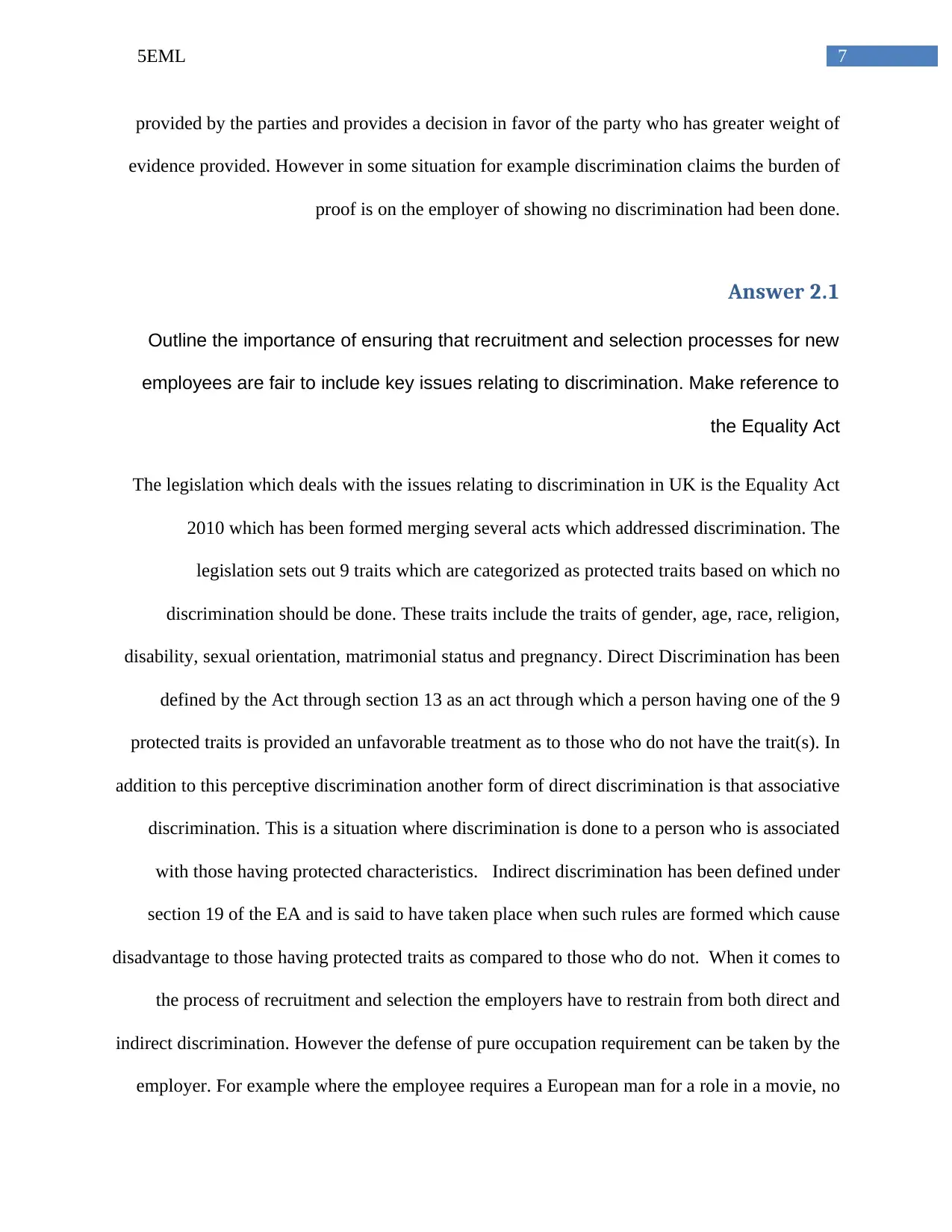
75EML
provided by the parties and provides a decision in favor of the party who has greater weight of
evidence provided. However in some situation for example discrimination claims the burden of
proof is on the employer of showing no discrimination had been done.
Answer 2.1
Outline the importance of ensuring that recruitment and selection processes for new
employees are fair to include key issues relating to discrimination. Make reference to
the Equality Act
The legislation which deals with the issues relating to discrimination in UK is the Equality Act
2010 which has been formed merging several acts which addressed discrimination. The
legislation sets out 9 traits which are categorized as protected traits based on which no
discrimination should be done. These traits include the traits of gender, age, race, religion,
disability, sexual orientation, matrimonial status and pregnancy. Direct Discrimination has been
defined by the Act through section 13 as an act through which a person having one of the 9
protected traits is provided an unfavorable treatment as to those who do not have the trait(s). In
addition to this perceptive discrimination another form of direct discrimination is that associative
discrimination. This is a situation where discrimination is done to a person who is associated
with those having protected characteristics. Indirect discrimination has been defined under
section 19 of the EA and is said to have taken place when such rules are formed which cause
disadvantage to those having protected traits as compared to those who do not. When it comes to
the process of recruitment and selection the employers have to restrain from both direct and
indirect discrimination. However the defense of pure occupation requirement can be taken by the
employer. For example where the employee requires a European man for a role in a movie, no
provided by the parties and provides a decision in favor of the party who has greater weight of
evidence provided. However in some situation for example discrimination claims the burden of
proof is on the employer of showing no discrimination had been done.
Answer 2.1
Outline the importance of ensuring that recruitment and selection processes for new
employees are fair to include key issues relating to discrimination. Make reference to
the Equality Act
The legislation which deals with the issues relating to discrimination in UK is the Equality Act
2010 which has been formed merging several acts which addressed discrimination. The
legislation sets out 9 traits which are categorized as protected traits based on which no
discrimination should be done. These traits include the traits of gender, age, race, religion,
disability, sexual orientation, matrimonial status and pregnancy. Direct Discrimination has been
defined by the Act through section 13 as an act through which a person having one of the 9
protected traits is provided an unfavorable treatment as to those who do not have the trait(s). In
addition to this perceptive discrimination another form of direct discrimination is that associative
discrimination. This is a situation where discrimination is done to a person who is associated
with those having protected characteristics. Indirect discrimination has been defined under
section 19 of the EA and is said to have taken place when such rules are formed which cause
disadvantage to those having protected traits as compared to those who do not. When it comes to
the process of recruitment and selection the employers have to restrain from both direct and
indirect discrimination. However the defense of pure occupation requirement can be taken by the
employer. For example where the employee requires a European man for a role in a movie, no
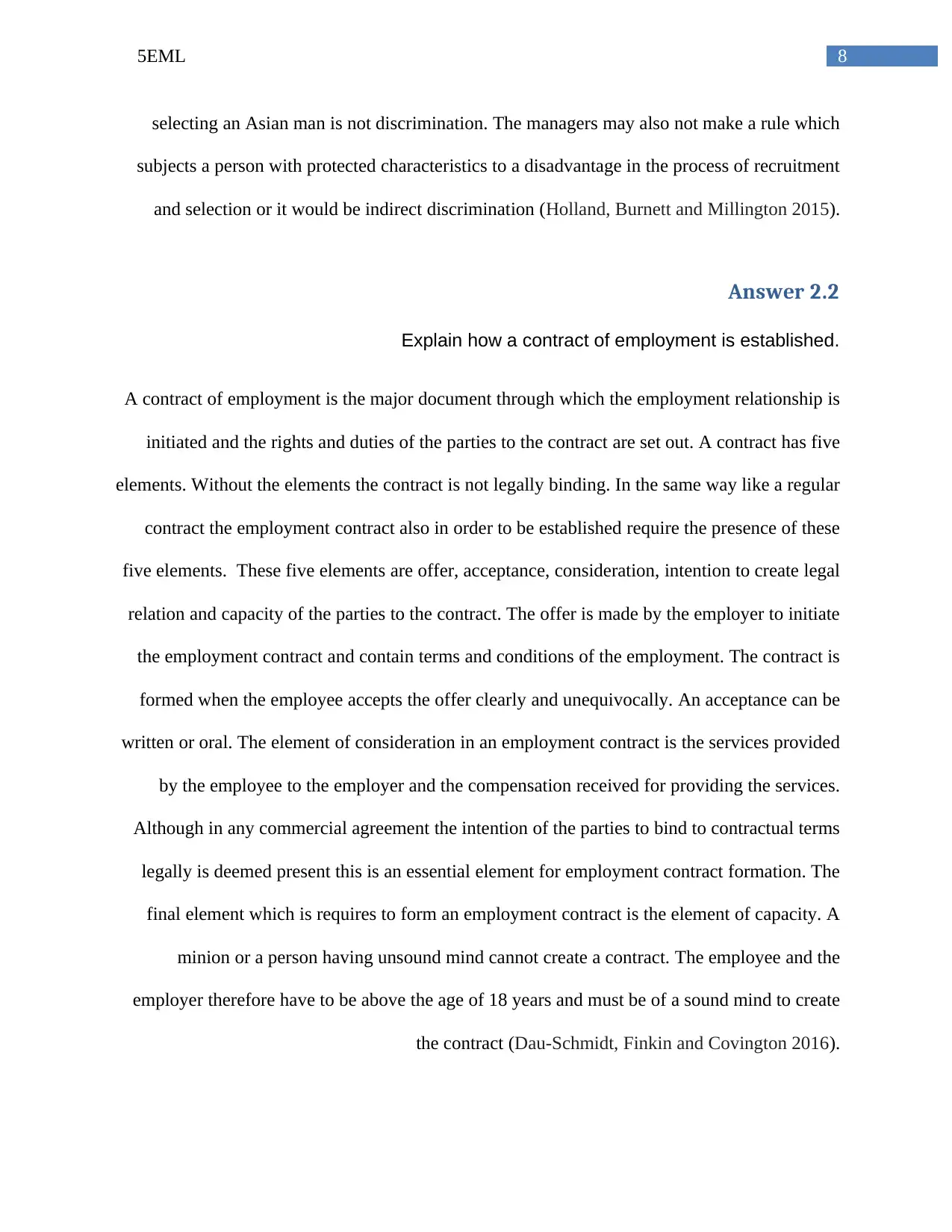
85EML
selecting an Asian man is not discrimination. The managers may also not make a rule which
subjects a person with protected characteristics to a disadvantage in the process of recruitment
and selection or it would be indirect discrimination (Holland, Burnett and Millington 2015).
Answer 2.2
Explain how a contract of employment is established.
A contract of employment is the major document through which the employment relationship is
initiated and the rights and duties of the parties to the contract are set out. A contract has five
elements. Without the elements the contract is not legally binding. In the same way like a regular
contract the employment contract also in order to be established require the presence of these
five elements. These five elements are offer, acceptance, consideration, intention to create legal
relation and capacity of the parties to the contract. The offer is made by the employer to initiate
the employment contract and contain terms and conditions of the employment. The contract is
formed when the employee accepts the offer clearly and unequivocally. An acceptance can be
written or oral. The element of consideration in an employment contract is the services provided
by the employee to the employer and the compensation received for providing the services.
Although in any commercial agreement the intention of the parties to bind to contractual terms
legally is deemed present this is an essential element for employment contract formation. The
final element which is requires to form an employment contract is the element of capacity. A
minion or a person having unsound mind cannot create a contract. The employee and the
employer therefore have to be above the age of 18 years and must be of a sound mind to create
the contract (Dau-Schmidt, Finkin and Covington 2016).
selecting an Asian man is not discrimination. The managers may also not make a rule which
subjects a person with protected characteristics to a disadvantage in the process of recruitment
and selection or it would be indirect discrimination (Holland, Burnett and Millington 2015).
Answer 2.2
Explain how a contract of employment is established.
A contract of employment is the major document through which the employment relationship is
initiated and the rights and duties of the parties to the contract are set out. A contract has five
elements. Without the elements the contract is not legally binding. In the same way like a regular
contract the employment contract also in order to be established require the presence of these
five elements. These five elements are offer, acceptance, consideration, intention to create legal
relation and capacity of the parties to the contract. The offer is made by the employer to initiate
the employment contract and contain terms and conditions of the employment. The contract is
formed when the employee accepts the offer clearly and unequivocally. An acceptance can be
written or oral. The element of consideration in an employment contract is the services provided
by the employee to the employer and the compensation received for providing the services.
Although in any commercial agreement the intention of the parties to bind to contractual terms
legally is deemed present this is an essential element for employment contract formation. The
final element which is requires to form an employment contract is the element of capacity. A
minion or a person having unsound mind cannot create a contract. The employee and the
employer therefore have to be above the age of 18 years and must be of a sound mind to create
the contract (Dau-Schmidt, Finkin and Covington 2016).
⊘ This is a preview!⊘
Do you want full access?
Subscribe today to unlock all pages.

Trusted by 1+ million students worldwide
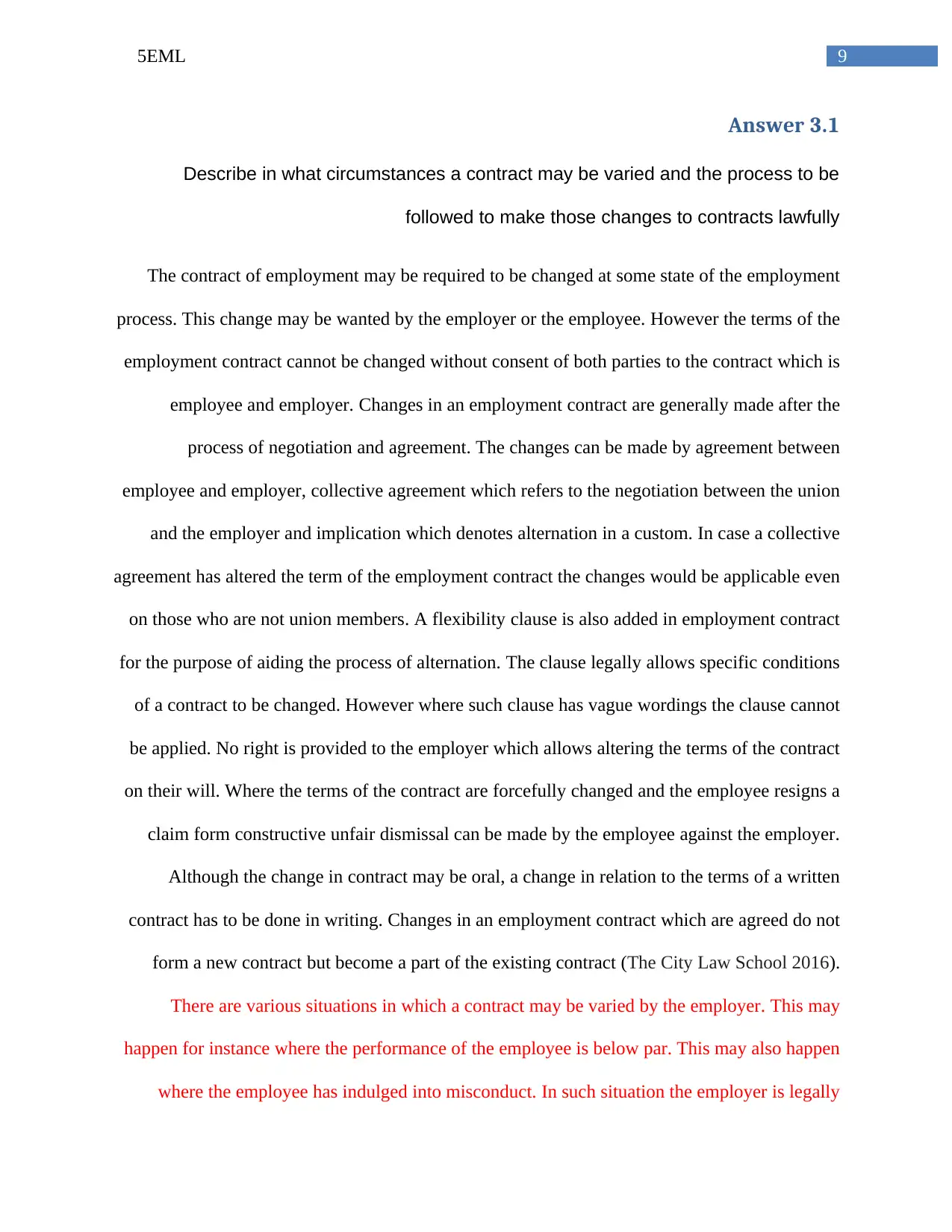
95EML
Answer 3.1
Describe in what circumstances a contract may be varied and the process to be
followed to make those changes to contracts lawfully
The contract of employment may be required to be changed at some state of the employment
process. This change may be wanted by the employer or the employee. However the terms of the
employment contract cannot be changed without consent of both parties to the contract which is
employee and employer. Changes in an employment contract are generally made after the
process of negotiation and agreement. The changes can be made by agreement between
employee and employer, collective agreement which refers to the negotiation between the union
and the employer and implication which denotes alternation in a custom. In case a collective
agreement has altered the term of the employment contract the changes would be applicable even
on those who are not union members. A flexibility clause is also added in employment contract
for the purpose of aiding the process of alternation. The clause legally allows specific conditions
of a contract to be changed. However where such clause has vague wordings the clause cannot
be applied. No right is provided to the employer which allows altering the terms of the contract
on their will. Where the terms of the contract are forcefully changed and the employee resigns a
claim form constructive unfair dismissal can be made by the employee against the employer.
Although the change in contract may be oral, a change in relation to the terms of a written
contract has to be done in writing. Changes in an employment contract which are agreed do not
form a new contract but become a part of the existing contract (The City Law School 2016).
There are various situations in which a contract may be varied by the employer. This may
happen for instance where the performance of the employee is below par. This may also happen
where the employee has indulged into misconduct. In such situation the employer is legally
Answer 3.1
Describe in what circumstances a contract may be varied and the process to be
followed to make those changes to contracts lawfully
The contract of employment may be required to be changed at some state of the employment
process. This change may be wanted by the employer or the employee. However the terms of the
employment contract cannot be changed without consent of both parties to the contract which is
employee and employer. Changes in an employment contract are generally made after the
process of negotiation and agreement. The changes can be made by agreement between
employee and employer, collective agreement which refers to the negotiation between the union
and the employer and implication which denotes alternation in a custom. In case a collective
agreement has altered the term of the employment contract the changes would be applicable even
on those who are not union members. A flexibility clause is also added in employment contract
for the purpose of aiding the process of alternation. The clause legally allows specific conditions
of a contract to be changed. However where such clause has vague wordings the clause cannot
be applied. No right is provided to the employer which allows altering the terms of the contract
on their will. Where the terms of the contract are forcefully changed and the employee resigns a
claim form constructive unfair dismissal can be made by the employee against the employer.
Although the change in contract may be oral, a change in relation to the terms of a written
contract has to be done in writing. Changes in an employment contract which are agreed do not
form a new contract but become a part of the existing contract (The City Law School 2016).
There are various situations in which a contract may be varied by the employer. This may
happen for instance where the performance of the employee is below par. This may also happen
where the employee has indulged into misconduct. In such situation the employer is legally
Paraphrase This Document
Need a fresh take? Get an instant paraphrase of this document with our AI Paraphraser
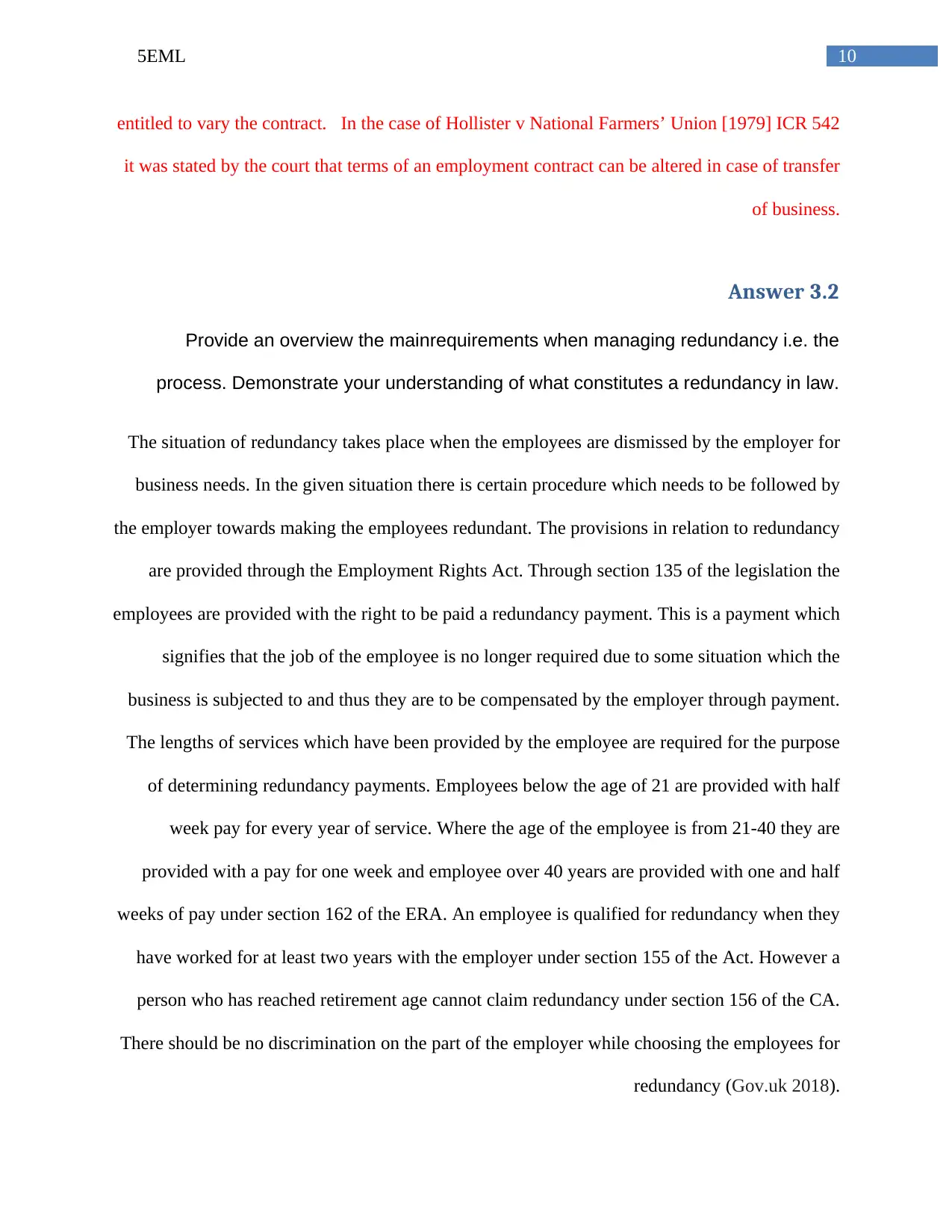
105EML
entitled to vary the contract. In the case of Hollister v National Farmers’ Union [1979] ICR 542
it was stated by the court that terms of an employment contract can be altered in case of transfer
of business.
Answer 3.2
Provide an overview the mainrequirements when managing redundancy i.e. the
process. Demonstrate your understanding of what constitutes a redundancy in law.
The situation of redundancy takes place when the employees are dismissed by the employer for
business needs. In the given situation there is certain procedure which needs to be followed by
the employer towards making the employees redundant. The provisions in relation to redundancy
are provided through the Employment Rights Act. Through section 135 of the legislation the
employees are provided with the right to be paid a redundancy payment. This is a payment which
signifies that the job of the employee is no longer required due to some situation which the
business is subjected to and thus they are to be compensated by the employer through payment.
The lengths of services which have been provided by the employee are required for the purpose
of determining redundancy payments. Employees below the age of 21 are provided with half
week pay for every year of service. Where the age of the employee is from 21-40 they are
provided with a pay for one week and employee over 40 years are provided with one and half
weeks of pay under section 162 of the ERA. An employee is qualified for redundancy when they
have worked for at least two years with the employer under section 155 of the Act. However a
person who has reached retirement age cannot claim redundancy under section 156 of the CA.
There should be no discrimination on the part of the employer while choosing the employees for
redundancy (Gov.uk 2018).
entitled to vary the contract. In the case of Hollister v National Farmers’ Union [1979] ICR 542
it was stated by the court that terms of an employment contract can be altered in case of transfer
of business.
Answer 3.2
Provide an overview the mainrequirements when managing redundancy i.e. the
process. Demonstrate your understanding of what constitutes a redundancy in law.
The situation of redundancy takes place when the employees are dismissed by the employer for
business needs. In the given situation there is certain procedure which needs to be followed by
the employer towards making the employees redundant. The provisions in relation to redundancy
are provided through the Employment Rights Act. Through section 135 of the legislation the
employees are provided with the right to be paid a redundancy payment. This is a payment which
signifies that the job of the employee is no longer required due to some situation which the
business is subjected to and thus they are to be compensated by the employer through payment.
The lengths of services which have been provided by the employee are required for the purpose
of determining redundancy payments. Employees below the age of 21 are provided with half
week pay for every year of service. Where the age of the employee is from 21-40 they are
provided with a pay for one week and employee over 40 years are provided with one and half
weeks of pay under section 162 of the ERA. An employee is qualified for redundancy when they
have worked for at least two years with the employer under section 155 of the Act. However a
person who has reached retirement age cannot claim redundancy under section 156 of the CA.
There should be no discrimination on the part of the employer while choosing the employees for
redundancy (Gov.uk 2018).
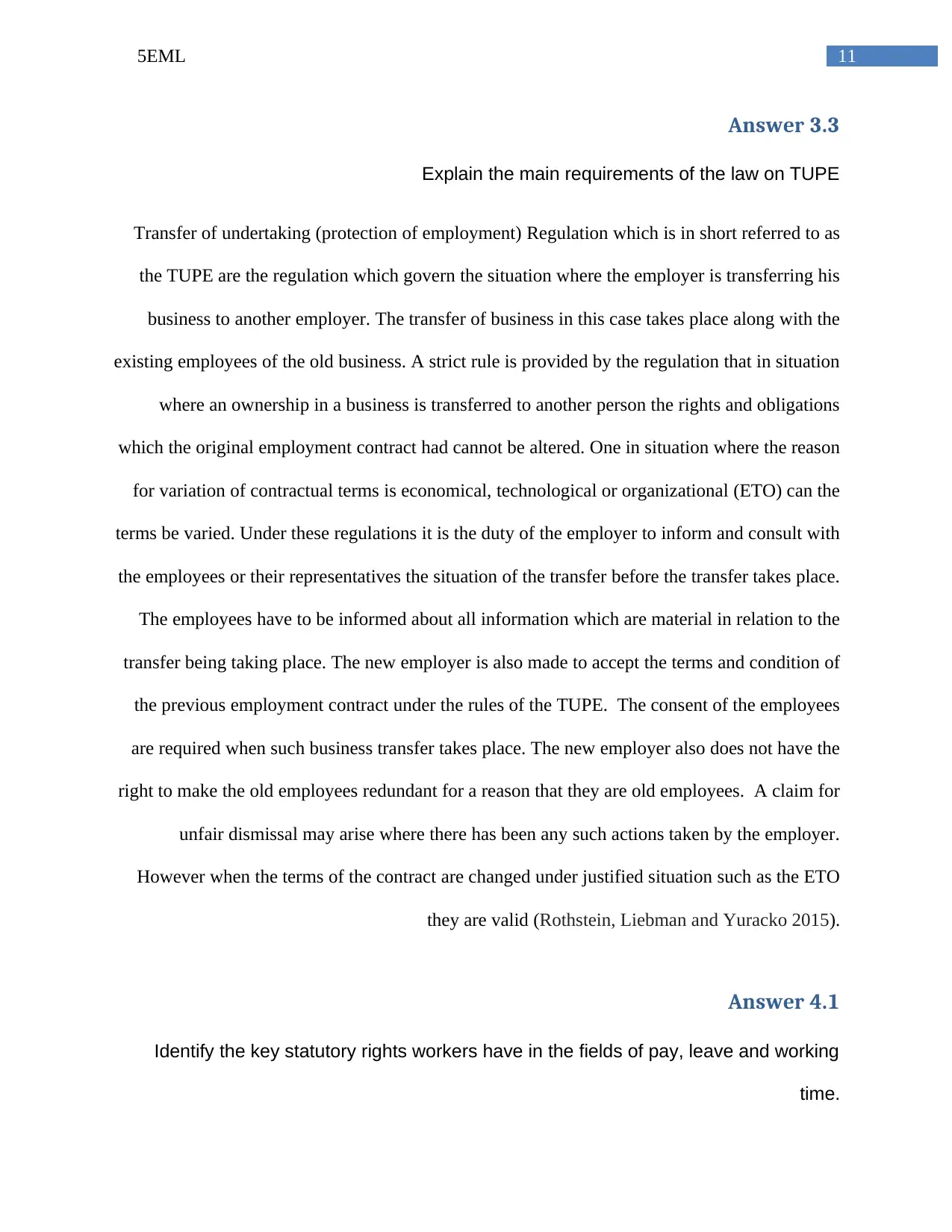
115EML
Answer 3.3
Explain the main requirements of the law on TUPE
Transfer of undertaking (protection of employment) Regulation which is in short referred to as
the TUPE are the regulation which govern the situation where the employer is transferring his
business to another employer. The transfer of business in this case takes place along with the
existing employees of the old business. A strict rule is provided by the regulation that in situation
where an ownership in a business is transferred to another person the rights and obligations
which the original employment contract had cannot be altered. One in situation where the reason
for variation of contractual terms is economical, technological or organizational (ETO) can the
terms be varied. Under these regulations it is the duty of the employer to inform and consult with
the employees or their representatives the situation of the transfer before the transfer takes place.
The employees have to be informed about all information which are material in relation to the
transfer being taking place. The new employer is also made to accept the terms and condition of
the previous employment contract under the rules of the TUPE. The consent of the employees
are required when such business transfer takes place. The new employer also does not have the
right to make the old employees redundant for a reason that they are old employees. A claim for
unfair dismissal may arise where there has been any such actions taken by the employer.
However when the terms of the contract are changed under justified situation such as the ETO
they are valid (Rothstein, Liebman and Yuracko 2015).
Answer 4.1
Identify the key statutory rights workers have in the fields of pay, leave and working
time.
Answer 3.3
Explain the main requirements of the law on TUPE
Transfer of undertaking (protection of employment) Regulation which is in short referred to as
the TUPE are the regulation which govern the situation where the employer is transferring his
business to another employer. The transfer of business in this case takes place along with the
existing employees of the old business. A strict rule is provided by the regulation that in situation
where an ownership in a business is transferred to another person the rights and obligations
which the original employment contract had cannot be altered. One in situation where the reason
for variation of contractual terms is economical, technological or organizational (ETO) can the
terms be varied. Under these regulations it is the duty of the employer to inform and consult with
the employees or their representatives the situation of the transfer before the transfer takes place.
The employees have to be informed about all information which are material in relation to the
transfer being taking place. The new employer is also made to accept the terms and condition of
the previous employment contract under the rules of the TUPE. The consent of the employees
are required when such business transfer takes place. The new employer also does not have the
right to make the old employees redundant for a reason that they are old employees. A claim for
unfair dismissal may arise where there has been any such actions taken by the employer.
However when the terms of the contract are changed under justified situation such as the ETO
they are valid (Rothstein, Liebman and Yuracko 2015).
Answer 4.1
Identify the key statutory rights workers have in the fields of pay, leave and working
time.
⊘ This is a preview!⊘
Do you want full access?
Subscribe today to unlock all pages.

Trusted by 1+ million students worldwide
1 out of 23
Related Documents
Your All-in-One AI-Powered Toolkit for Academic Success.
+13062052269
info@desklib.com
Available 24*7 on WhatsApp / Email
![[object Object]](/_next/static/media/star-bottom.7253800d.svg)
Unlock your academic potential
Copyright © 2020–2025 A2Z Services. All Rights Reserved. Developed and managed by ZUCOL.





